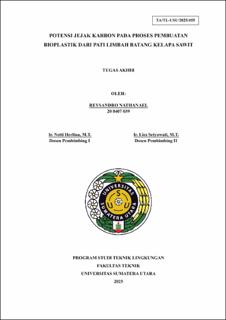| dc.description.abstract | Conventional plastic is a significant contributor to environmental pollution in Indonesia. One approach to reducing such pollution is by producing eco-friendly products, such as bioplastics, which are biodegradable plastics. However, the production of bioplastics also generates carbon footprints at various stages. This study aims to calculate the carbon footprint of bioplastic production using starch derived from oil palm trunk waste and analyze the product's contribution to greenhouse gas emission mitigation. The bioplastics used in this study were made from oil palm trunk starch as the primary raw material. Each production process was identified to assess its potential carbon footprint, and the carbon footprint values were calculated based on the IPCC 2006 Guidelines. The percentage of potential emissions generated in the production of bioplastics using cellulose from oil palm trunk powder was 82,682% for CO2, 17,316% for CH4, and 0,002% for N2O. Meanwhile, the potential emissions from bioplastics produced with cellulose from starch residues were 82,632% for CO2, 17,366% for CH4, and 0,002% for N2O. The bioplastic type with the highest potential carbon footprint was the one made with cellulose from oil palm trunk powder, producing a carbon footprint 2,6% higher than that of bioplastics made with cellulose from starch residues. The stage with the highest potential carbon footprint was starch isolation, contributing 84% of the total carbon footprint in the production of bioplastics using cellulose from oil palm trunk powder and 86% in bioplastics using cellulose from starch residues of oil palm trunks. | en_US |


